This is your ultimate guide to actionable customer research in B2B, tailored especially for SaaS & subscription companies.
In this guide, you’ll not only learn how to conduct customer research but also get the theory to back it up and arguments to get buy-in.
It also includes some actionable templates you can use to step up your customer research right away.
Here's a breakdown of what we'll cover:
- What is customer research & why it matters
- The 5-step guide for customer research in B2B SaaS
- The most common obstacles and how to tackle them
- Conclusion
What is customer research & why it matters
Customer research is the process of identifying your ideal (and not-so-ideal) customer segments, their motivations, behaviors, and unmet needs. Based on this, you’ll identify opportunities for business growth.
Why is it so important then?
Just look at these ProfitWell statistics:
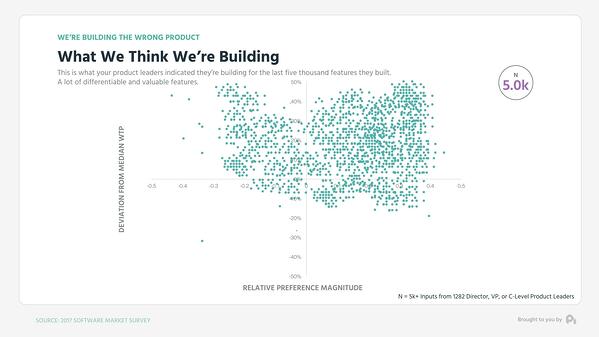 What companies think they’re building... Image source
What companies think they’re building... Image source
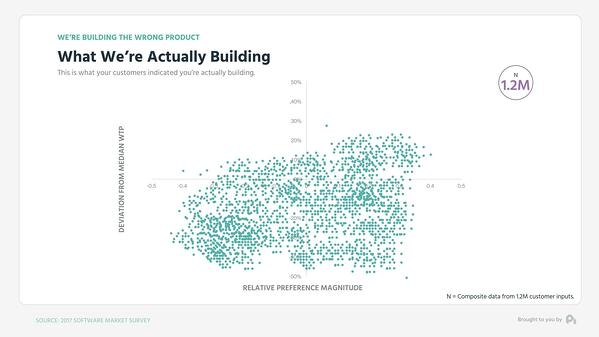
...and what their customers think they’re buying. Image source
As the research suggests, a fact that typically gets fatally neglected is that your company’s internal perception of value does not equal your customers’ perception of it.
And if that was not enough,
- Companies that invest in ongoing customer research are able to grow 2–3 times faster than those that don’t.
- B2B marketers who can’t talk to customers are 27% less likely to be happy with their content’s business results.
- Those who conduct customer research are 466% more successful than those who don’t.
- The most successful marketers are 242% more likely to conduct audience research at least once per quarter —and 56% of the most elite marketers are actually doing it monthly. Coincidence? I think not.
No wonder many of today’s fastest-growing companies like Drift are practically preaching about talking to your customers on a regular basis:
“I love data, but it’s like driving a car using only the rearview mirror. It tells you what happened, not what is going to happen.”
– David Cancel, CEO and founder of Drift
And that’s what “customer research” is all about: knowing who your best customers are and what they want, and then using that data to grow your business sustainably.
Yet, most people (up to 65% of all marketers!) don’t conduct any kind of customer research. Ever.
“Got it,” you’re probably thinking to yourself right now: “I clearly need to invest in some research. But what the heck does that mean in practice?”
Well, you’re just about to find that out.
The 5-step guide for customer research in B2B SaaS
Here are your 5 steps to more actionable customer research.
Step 1: Letting go of the old “customer insights”
Before you start doing any actual research, it’s time to reset your understanding of “customer insights” so that you’ll be able to focus on the right things from the get-go.
You’ll want to understand who your best customers are, why they buy from you, and what resonates with them.
Unfortunately, this information doesn’t automatically come from general industry knowledge or long experience. Instead, you’ll want to understand what’s going on in your customers’ heads.
Now, let’s talk about how you will actually get that information.

What’s wrong with traditional buyer personas?
Most marketers are familiar with a framework called “buyer personas.” The first-ever marketing personas were created somewhere in the 1990s, but demographic and psychographic segmentation had been widely used in B2C mass marketing well before that, often with great success.

A typical B2C buyer persona that’s based on demographics and psychographics.

A typical B2B buyer persona that is based on demographics,
psychographics, and firmographics.
Now, these “archetypal representations of your ideal buyer” rarely work for B2B (especially for tech-forward SaaS and subscription companies), for a few reasons:
- Buyer personas are traditionally too much based on demographics (such as titles and roles in B2B) and psychographics, rather than contextual (problem-specific) motives. How is the fact assumption that the buyer is business-savvy or looking to get an extra bonus going to help you sell CRM?
- Buyer personas mainly focus on, well, personas. In B2B, the obvious problem is, that they lack information on customer segments (more on that later), and the market is typically segmented superficially (e.g. only based on company size even if it's not the main differentiator).
- For the same reasons, B2B buyer personas typically assume that people with the same title (e.g. CEOs) are a homogenous mass, with the same motives and pain points —regardless of the context (e.g. a mature Fortune 500 company or a fresh hi-tech startup with novel technology).
- Buyer personas only focus on buyers and not the users, and therefore fail to recognize other important parts of your customer’s journey, which are crucial in B2B and especially subscription-based businesses, for which retention and upsell are crucial.
- Finally, buyer personas are often pulled out of thin air as a result of an internal brainstorming session. And even if they were based on real interviews, the typical interview questions are often not very useful (more about that in a bit).
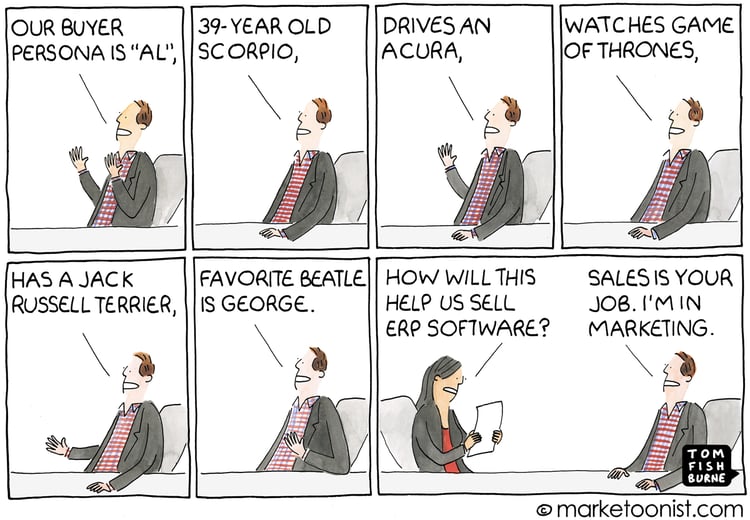 The biggest problem with traditional B2B buyer personas is that they don’t help you make informed marketing decisions. Image source.
The biggest problem with traditional B2B buyer personas is that they don’t help you make informed marketing decisions. Image source.
How to do better “buyer persona” research in B2B SaaS by using the jobs-to-be-done framework
There are a few different alternatives you can use instead of (or combined with) traditional personas (e.g. usage scenarios), but for B2B SaaS and subscription businesses, we typically like to use a framework called Jobs to Be Done.
The idea behind the framework is that people “hire” products and services to get a certain “job” done.
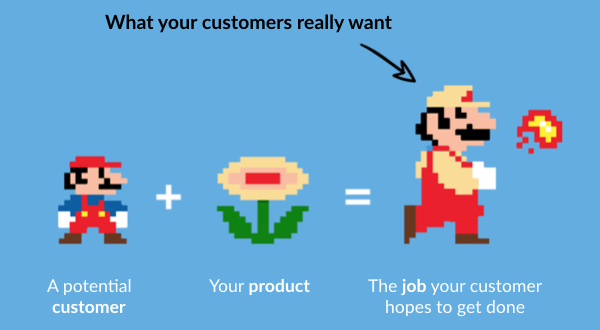
A job to be done essentially describes the “better me”: Now that you have this product, what can you do that you couldn’t do before? Image source.
As opposed to traditional personas, the jobs framework focuses on contextual motivations and aims to identify the causal driver behind a particular purchase (rather than a permanent attribute).
In order to determine a “job to be done” that a customer has for a product or service, you have to understand what problems this customer is trying to solve within particular circumstances.
Here's how different a Job to be done for a smoothie could look like for different people:

And here are some example jobs for real B2B SaaS companies:
- For a video recruitment platform, the “job to be done” of someone who’s in charge of a company’s recruitment (regardless of the title) could be to identify, attract, and recruit the right people for relevant roles within an organization as quickly as possible.
- For a medical practice management software, the “job to be done” for the business decision-maker who works in centralized management of the clinic chain could be to improve and grow their medical business by making better data-driven decisions.

From superficial buyer personas to contextual jobs to be done.
What’s good to keep in mind, though, is that while in B2C a job to be done can be as simple as buying a milkshake to keep your kid conveniently distracted while doing groceries, in B2B things can get a bit more complex — and the same applies to defining your customers’ job to be done.
Here are a few things to keep in mind when doing the research:
- Complicated products and highly customizable services tend to have many (possible) jobs. Think ERP!
- The same product can have different jobs for different people (even single-feature products). Think Google Sheets!
- A customer's job can (and most likely will) change within time: a CRM is first used for organizing data, then for improving processes, and finally for scaling ops.
- Most B2B buying processes include many people with several different, often conflicting jobs (optimizing for cost efficiency or good usability vs minimizing risks, and so on).
Phew! Now that we have the theory in place, let’s move forward and get to work.
Step 2: Defining your Ideal Customer Profile
“Your ideal customer profile is a clear, common, objective definition of who the ideal buyers and users of your product are.”
What is an Ideal Customer Profile — and how do you create one?
As I briefly mentioned in the last section, before you can start interviewing people, it’s important to understand who are your best customers — and then interview people only from those companies, and not just anyone with a heartbeat.
This distinction between ideal and not-so-ideal customers is crucial, because you'll want to align all your efforts around the first category, and not so much the second.
To put it in short, your ideal customers are those that...
- intuitively understand the benefits and see the value of your product
- are easy to sell to
- don't ask for a lower price
- don’t churn easily (or in transactional sales: buy over and over again)
- are profitable for your company (think relatively low customer acquisition costs, relatively high customer lifetime value, and high growth potential)
- often recommend your product/service to their peers — simply because they’re head over heels for it
When it comes to customer segmentation, there’s a catch you should be aware of: your customers (both companies and key people within those) don't always fall into any clear firmographic or demographic categories (still remember the good old personas?).
Instead, what a group of customers has in common is typically what they're trying to achieve with your product/service (still remember the job-to-be-done framework?).
Having all this in mind, there are two ways to define your ICP: based on customer data, or based on customer characteristics.
- Data-based profile: If possible, try to get some real customer data of who are your most profitable and fastest-growing accounts (think things like customer lifetime value, account growth rate, and customer acquisition cost) and reverse-engineer your ICP from there.
- Characteristics-based profile: If there’s not enough data available (e.g. you’re building a new product or entering a new market, or you just haven’t used your CRM properly —and this can happen to the best of us, believe me), you’ll need to settle for the characteristics-based profile for now (and dig into data once you have enough of it).
Running an ICP workshop
The second case is surprisingly common, so here’s a quick walkthrough of how to define the characteristics-based ICP.
It's typically done by hosting a common workshop where you'll want to invite at least sales, marketing, product, and customer success. If possible, you can also invite business.
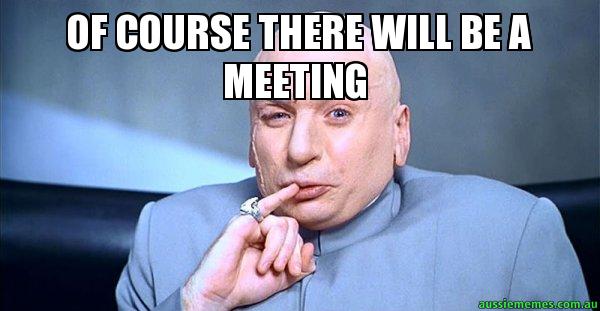
How to get the right people to attend the workshop? Just download our handy invite email template (alongside with a handful of other templates), and you should be good to go.
The goal of the workshop is to agree on a common ICP definition per one product/service offering, and the agenda typically looks something like this:
- Identify your best customers based on the criteria above.
- Group them in different segments and define the customer segment characteristics.
- Prioritize the segments based on customer profitability/potential, company strategy, and your general knowledge. (We typically recommend focusing on just one segment in the beginning.)
- Walkthrough the buying process (for each segment), and identify the people involved in the process, their roles, and the most pressing questions and concerns.
The process itself is relatively simple but as I mentioned before, the problem is that when people think about customer segments, they typically think of firmographic factors like annual revenue, employee count, industry/vertical, geographic markets served, maturity, growth stage, business objectives, or organizational structure.
And while these factors can be relevant, in many cases they are not.
I mean, just think about this:
Company X buys 100 telephone subscriptions because there are 100 employees in the company. But they won’t buy a project management tool due to the fact alone that there are 100 employees. Instead, they will buy a project management tool because these 100 employees need to get something specific done that this tool can help them with.
In other words, what matters the most is how your product or service will help your customers reach their goals.
And that may or may not have something to do with firmographics.
That’s why an ICP can (and often should) be defined by using different characteristics instead of just firmographics, including things like:
- technographic (tech stack)
- behavioral indicators (e.g. a recurring need to do something)
- social and cultural characteristics (e.g. company culture, tech-forwardness, ways of working, values, etc.)
- changes in the company that indicate a change in needs (e.g. takeovers, structural changes, key hires, etc.)
- changes in the environment that force the company to react somehow (e.g. economic downhill, regulatory changes, etc.)
- or anything else that happens to be relevant for your business.
What's a good ICP?
Let me give you an example of an actionable ideal customer profile and briefly explain how we came up with that.
Company X founded a novel AI-powered tool that removes manual work from certain financial administration workflows through automation.
To benefit from the tool, a company should process at least 100,000 invoices annually.
This is what we knew based on the company's general knowledge and it could’ve been the company’s ICP, but we decided to go a bit deeper.
The thing is, not all big companies process an equal amount of invoices: the more complex the industry, the more invoices the company is likely to have.
In addition to that, by interviewing the target group we found out that while some CIOs found the new tool extremely appealing and were happy to go all-in on this new technology, others were a bit hesitant to try something that they had never even heard of before and that would not necessarily bring them instant value.
So instead of targeting just any corporations and CIOs, Company X should go after corporate chains and companies that are operating in a complex industry such as leasing or construction and are early adopter CIOs who want to reposition the finance department as a forerunner in driving technological innovation.

The lesson learned: Superficial, purely firmographics-based “ICPs” aren’t typically precise enough to help you understand your customers’ motives and behavior.
Prioritize the most important segments... and get to work!
Now that you’ve identified your ideal and not-so-ideal customers and segmented them into groups, it’s time to first prioritize the most important segments (if you have more than just one), and then move on to investigating their buying processes.
First, have your salespeople walk through a typical sales process from their own point of view—don’t make them speculate about what’s going on in your customers’ heads. If you decide to focus on multiple products or customer segments simultaneously, you may need to repeat this step a few times.
While they’re talking, aim to identify the most important touchpoints, as well as customers’ typical questions and their most pressing concerns, and try to identify the people involved in the buying process.
Don’t worry if you’re left with a lot of blanks to fill in (and I guarantee that you will), because that’s exactly where the customer interviews come in handy.
Step 3: Conducting the interviews
First, a quick disclaimer:
We’ll only talk about qualitative customer research (or "Voice of Customer") here, but that doesn’t mean that you shouldn’t do quantitative research (“data analysis”) as well. You’ll also want to explore your web analytics, CRM, and product data for insights like:
- How are your customers behaving & buying online?
- What social and other channels are they using and how?
- What content are they consuming? What’s converting best? Who are the most and least likely to convert?
- What search queries are they using? What’s the search intent behind those?
- How are they using the product? Who is the most likely to churn, and what happens right before that? Who is the least likely to churn? What do these customers have in common?
- Who are your most profitable customers? What do they have in common? What about the least profitable?
Now, let's get back to our qualitative research method — in-depth customer interviews.
How to do a good customer research interview
Before you pick up the phone, here’s a quick checklist for conducting top-notch customer interviews.
- After you’ve run the ICP workshop, start by making a list of customers that belong to the ideal customer segment, and have been your customers long enough to have experienced the benefits, but short enough to still remember the situation before partnering up with you.
- As a rule of thumb, you should do at least 3-5 interviews per customer segment to gain enough understanding.
- Interview whoever is relevant. This can be anything from a C-level decision-maker to a manager, from an assistant to an external consultant. And sometimes you should talk to people representing several roles instead of just one.
- Make sure that someone the clients know reaches out to them before you book the calls. The right person for this is typically a salesperson, account manager, or customer success manager.
- Once they’ve agreed to be interviewed, schedule 45-60 min phone calls with the customers, and send them a calendar invite.
- When planning the interviews, always start with defining the most important things you want to focus on if you start running out of time. Think things like what’s the sales process like, who you’re going to interview, what kind of information is missing, what other sources you can use, etc.
How can you encourage salespeople to reach out to the interviewees beforehand? Just forward them our handy outreach email template.
Helpful customer interview questions for marketers
As opposed to traditional persona interviews, you don’t want to spend too much time exploring their (fictional) demographics or psychographics.
Instead, you’ll want to figure out things like:
- Background & context: What’s their core business, and in what context are they operating?
- Use & impact: What are they trying to achieve, and what part does your solution play in this? What has changed for the better after they started using your solution? What are the perceived benefits?
- Process before & triggers for change: What are their triggers & motivations for change? What’s their stage of awareness in terms of different solutions?
- Buying (discovery, comparison & decision criteria): How do they typically discover your product? What does a typical buying process like? Who’s involved in the process and what are their roles? What are their goals and expectations for a solution like yours? What’s their decision-making criteria? What are the perceived barriers? What do they see as alternatives and competition?
- Information seeking: How and where do they look for information and what sources do they find the most trustworthy?
Need a helping hand with planning the interviews? Just borrow the list of interview questions that we use for our customers.
A few simple customer interview techniques and tactics
After having done dozens of customer research interviews (and hundreds of other interviews) over the past years, I've learned a thing or two about what works and what doesn't. Here are my 2 cents:
- At the beginning of the call, frame it as a discussion about her goals and bottlenecks at work and how [product XYZ] has helped her make progress —not an interrogation about your product.
- Ask mostly open-ended questions to avoid steering the conversation too much.
- Summarize and use leading questions to make sure you’re following her train of thought and to get enough concrete examples (“You mentioned that you have struggled with XYZ. Why did you bring that up?” "Can you come up with any real-life examples of XYZ?")
- Try to rephrase tricky questions once or twice instead of skipping them. If the interviewee freezes when you ask about her most important success metrics at work, you can rephrase and ask about her top priorities instead.
- Learn to deal with awkward silences, and don't break the silence right away. This gives the interviewee time to think.
- Never ask why they did something because that forces the interviewee to rationalize, which is counterproductive because people don’t usually act “rationally.” Instead, try to have them tell you what happened first and then, how did they react to it, how did they feel about that, etc.
- Finally, always record the call. The easiest way to do that is to use a video call tool like Zoom that allows you to record the call. Even if you managed to get perfect notes substance-wise, you will want to use the same words the interviewee did to create empathy.

Step 4: Analyzing the results
Now that you have the data, it’s time to start analyzing what you have just collected.
This step may look like extra work (you wouldn’t believe how many people are tempted to skip this), but do yourself a favor and try to resist that temptation.
Why?
Because only by compiling the data manually you actually start absorbing the information properly and notice what’s most important: patterns in the data. This part is a bit messy, but it's a natural part of the process.
And here’s how to do that:
- If you (hopefully) used a recorder, start by transcribing the interviews (or just use rev.com). You’ll want to have the exact words in writing, not just the rough idea.
- When you have everything in writing, group the answers by topic (use the template below).
- After that, you’re good to start looking for patterns in things like jobs to be done, awareness stage, motivations, pain points, use cases, etc.
- If needed, divide customers into different segments based on their job to be done rather than things job titles or company size
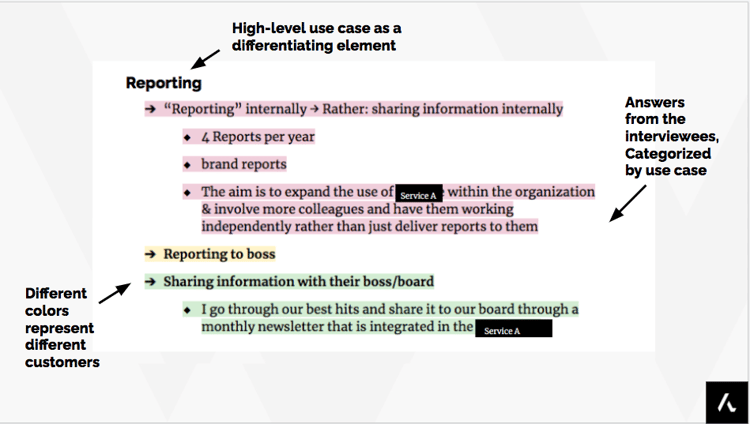 Example: How to make sense of the interview data
Example: How to make sense of the interview data
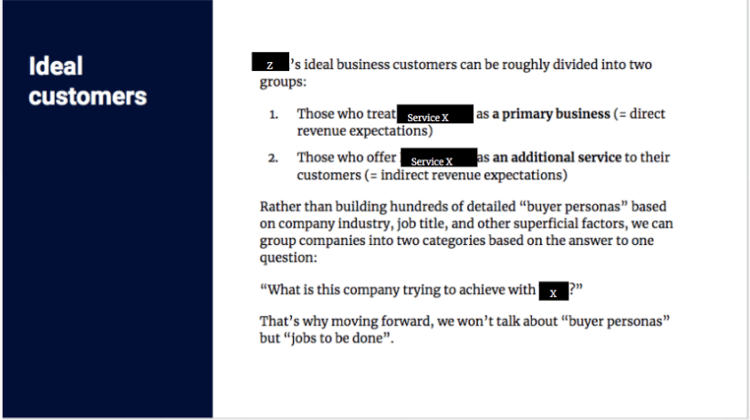
Example: High-level description of different customer segments
Don’t know how to make sense of the data? Just swipe our customer research summary template.
Step 5: Applying the findings
Customer research is so valuable because the findings can be used in a variety of ways:
- Positioning
- Refining brand and product messaging and creating a value proposition
- Writing sales and marketing copy
- Creating a content marketing strategy and prioritizing themes, topics, channels, and tactics
- Onboarding new employees (at least sales, marketing, customer success, and product)
- Optimizing product onboarding
- Prioritizing product development
And so on. Here are a few real-life examples of how to use customer research.
Example A: Value proposition that resonates with the target audience
The founder of Zoom used to work for another video conferencing company and knew that their customers really struggled with lousy video conferencing tools.
He understood the pain points simply because he had seen so many clients struggling with them from close by and felt like the company he worked for wasn’t paying enough attention to these signals from the field. So he decided to build a tool that, well, doesn’t suck. (Hence the original value prop.)
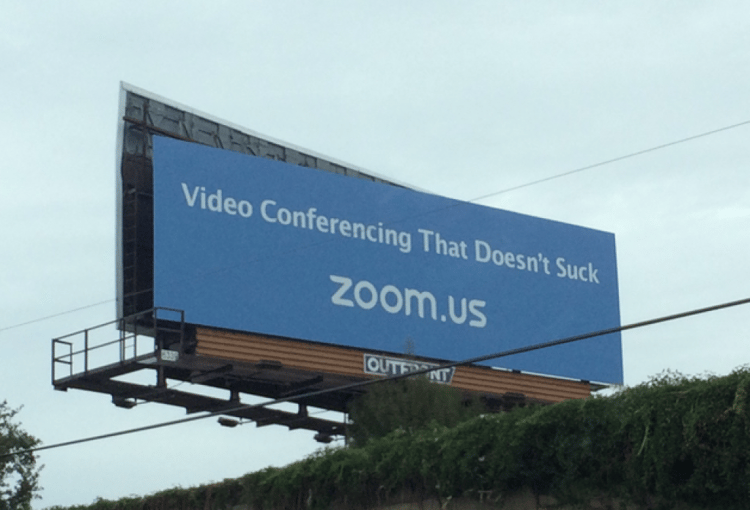
Example B: Empathetic copywriting that communicates the benefits
This is probably a no-brainer for most SaaS marketers, but customer research (done in the right way) is a perfect source of instantly swipeable copy. And if you haven’t tried that yet, believe me — stealing copy directly from your customers’ mouths makes it so much more approachable than using generic industry/marketing jargon!
Let’s say you’re working for a medical practice management software company.
An interviewee mentions that one of the best things about the software she’s using at work is the ability to send automated SMS reminders to the patients, because “without that, it would be postcards and stamps.”
In other words, they would have to spend a lot of time sending out reminder letters weeks in advance and then simply hope for the best. With automated SMS reminders, however, they could send their patients timely reminders without any manual work.
The feature itself is clearly appealing, but which copy you think is more relatable to her peers (aka your potential customers), A or B?
- “[Product X] has an automated application on SMS confirmations and reminders.“
- “Forget about postcards and stamps. [Product X]’s scheduled SMS reminders let you connect with your patients whenever you need and reduce no-show appointments.”
The answer is B. Not just because it clearly explains the benefits, but also because it pinpoints the real-life pain points and uses familiar language.
Example C: Content marketing that converts
You need customer interviews not just because of empathy, but also because salespeople simply can’t tell you what they don’t know.
This was the case with a company that offers a remote monitoring service, that helps property owners measure their water usage and catch plumbing leaks before it’s too late.
After talking to their salespeople, the original idea was to create an ebook about water usage and cost efficiency, which would then be targeted for property managers.
The customer research, however, revealed that the most potential target audience could be high-end hotel chains interested in being sustainability leaders. Cost management, on the other hand, was not very high on their priority list due to high margins.
We decided to give it a try — and relevant leads started flowing in.
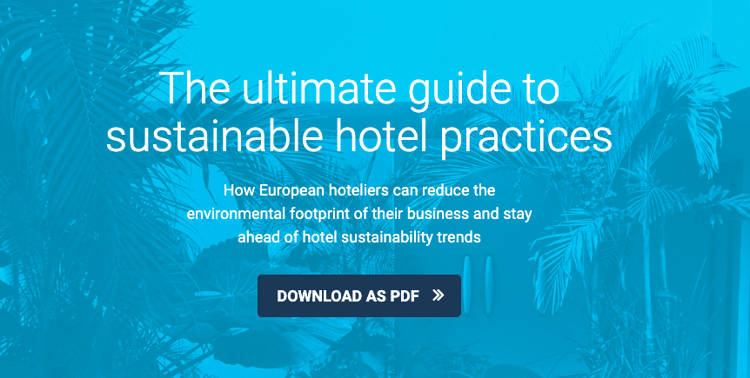
The most common obstacles and how to tackle them
Before you jump into action, let’s quickly talk about the preconditions for succeeding.
The two most common obstacles are not having enough ideal customers to interview, and not getting internal buy-in.
Problem 1: Not enough ideal customers to interview
If you don’t have at least a handful of happy customers (preferably marketing-generated), customer research isn’t necessarily the best way to go about getting to know the target audience. This is often the case if you have a new product, or if you’re looking to reposition your product or expand to a new market (= no market/product fit).
In that case, you could always try some alternative approaches:
- interview your competitors’ customers (if they represent your target audience), or your prospects
- conduct online/email surveys
- research industry forums & communities and review sites
None of these, however, can completely replace a good in-person interview with a happy, good-fit customer.
That’s why we would first recommend spending some time validating your market-product fit with a more sales-led approach and/or by taking a more exploratory approach to help you discover, test and validate business assumptions and hypothesis with controlled experiments (e.g. PPC), and focus on customer validation/development instead.
Problem 2: Not getting internal buy-in
If you haven’t experienced the benefits first-hand, you may not understand the value of customer research.
So if you need to first get internal (especially C-level) buy-in for customer research, be prepared to address any challenges posed by stakeholders and try to make them understand that the only audience that matters is your ideal customers — not your C-suite or anyone else working for the company.
The best way to avoid having to ask for permission at all is to reframe research into actionable (mandatory) steps (which it essentially is).
So stop saying: “I want to do some customer research” and start saying: “In order for this project to succeed, I need answers to these specific questions. Here’s how I’m planning to get that information.”
If that doesn’t work, here’s a list of some of the most common objections we’ve seen over and over again, and how to handle them.
Objection: “We already know our customers. I can provide you with whatever information you need!”
- Explain the value by using their language (instead of marketing jargon) and tie the benefits back to important performance metrics. For instance, while many CEOs want to talk about their company or product, most prospects tend to dismiss content that’s too promotional or salesy (You can also use the statistics and data presented at the beginning of this blog post).
- Address the specific problems you don’t have answers to and explain how they’re going to keep the company from succeeding.
Objection: “We need results fast, so we need you to start executing this campaign right away.”
- Explain in detail how the lack of information is likely to decrease the performance, and then tie that back to the decision maker’s own success metrics.
- If that doesn't work, suggest a two-fold approach: Moving forward without the research for quick wins and, in the background, simultaneously starting to collect information that allows a more data-driven approach in the future.
Objection: “Research is too expensive, we can’t afford that.”
- Kind of a no-brainer, but it’s typically worth explaining that what you’re about to do is not what they probably think of when they hear the word “research” and that it’s only going to take a few phone calls, not an extensive 100K-and-2-year project.
Objection: “How are you going to get reliable results with just 5 interviews?”
- Easily – because we're not looking to get statistical data but to find patterns. Quantitative data (CRM, product analytics, web analytics, NPS surveys, customer support tickets, etc.) answers the "what?" and "how?" questions, such as how our customers are behaving online or using the product.
- Qualitative data (interviews, potentially also surveys if you have huge volumes), on the other hand, answers the "why?": why they're behaving in a particular way, what motivations are driving them, and so on. In short, the voice of the customer helps you understand the cause and effect of your clients' behavior. (The problem with surveys is that you need huge volumes to get anything interesting out of them and that you can't ask follow-up questions or rephrase.)
Objection: “We don’t want to bother our customers.”
- In our experience, most customers are actually more than happy to help — and they also feel special because the company is interested in hearing their thoughts. So conducting research is actually a good way to nurture those valuable relationships and to gain some information on the side. But if you really can’t make the decision-maker understand this, there are still a few workarounds you can try...
- Start hopping on the sales/customer success calls whenever you can, and have salespeople ask the client in advance if you could ask a few questions at the end of the call, which should take no more than 10 minutes. With some time and patience, you’ll end up with enough data to form a comprehensive view of your customers.
- Alternatively, you can team up with the sales/customer success teams and make them work for you. Provide them with the questions you need answers to and ask them to record the call so they don’t have to take notes.
Need to get internal buy-in from your boss? Modify our handy buy-in email template to your needs, and wait for the magic to happen.
And if everything else fails, just… do the research and don’t tell anyone else before you have the data to back you up. It will pay off, I promise.
4. Conclusion
If there’s just one thing you’re going to take away from this blog post, it should be this one: staying close to your ideal customers equals success. As Katelyn Bourgoin has famously put it: customer research truly is the most powerful “growth hack” companies can think of.
So, if you're looking to grow your B2B SaaS or subscription business sustainably and predictably but don't know exactly how to do so, look no further: start by downloading our free customer research templates.




